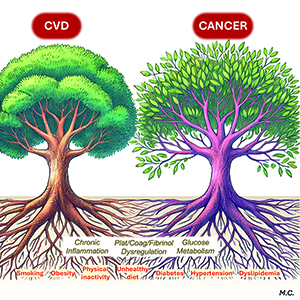Cancer complicated by thrombosis and thrombocytopenia: still a therapeutic dilemma

Submitted: 15 January 2024
Accepted: 5 April 2024
Published: 16 May 2024
Accepted: 5 April 2024
Abstract Views: 555
PDF: 180
Publisher's note
All claims expressed in this article are solely those of the authors and do not necessarily represent those of their affiliated organizations, or those of the publisher, the editors and the reviewers. Any product that may be evaluated in this article or claim that may be made by its manufacturer is not guaranteed or endorsed by the publisher.
All claims expressed in this article are solely those of the authors and do not necessarily represent those of their affiliated organizations, or those of the publisher, the editors and the reviewers. Any product that may be evaluated in this article or claim that may be made by its manufacturer is not guaranteed or endorsed by the publisher.
Most read articles by the same author(s)
- Kristen M. Sanfilippo, Tzu-Fei Wang, Venous thromboembolism and mortality in patients with hematological malignancies , Bleeding, Thrombosis and Vascular Biology: Vol. 3 No. s1 (2024): 12th ICTHIC
Similar Articles
- Vincenzo Sammartano, Adele Santoni, Elisabetta Zappone, Paola Calzoni, Daniela Fineschi, Eleonora Franceschini, Federico Caroni, Anna Sicuranza, Monica Bocchia, Luca Puccetti, A case of acquired factor XIII deficiency secondary to plasmablastic lymphoma , Bleeding, Thrombosis and Vascular Biology: Vol. 2 No. 1 (2023)
- Setor K. Kunutsor, Sudhir Kurl, Ari Voutilainen, Jari Laukkanen, Circulating albumin-to-fibrinogen ratio may be a risk indicator for venous thromboembolism: findings from a population-based prospective cohort study , Bleeding, Thrombosis and Vascular Biology: Vol. 1 No. 2 (2022)
- Pier Mannuccio Mannucci, Gene transfer in hemophilia A: not cogent yet , Bleeding, Thrombosis and Vascular Biology: Vol. 1 No. 1 (2022)
- Paolo Prandoni, Franca Bilora, Raffaele Pesavento, Giorgina Salgueiro, Angeles Blanco-Molina, Raquel Lòpez-Reyes, Manuel Monreal, and the RIETE Investigators, Treatment of venous thromboembolism in pregnancy: findings from the RIETE Registry , Bleeding, Thrombosis and Vascular Biology: Vol. 1 No. 2 (2022)
- Sarah Gallitto, Thomas C. Varkey, Jacob Lahti, Venous thromboembolism prophylaxis in orthopedic surgery: a narrative review , Bleeding, Thrombosis and Vascular Biology: Vol. 3 No. 3 (2024)
- Giovanni Di Minno, Gaia Spadarella, Ilenia Lorenza Calcaterra, Giancarlo Castaman, Paolo Simioni, Raimondo De Cristofaro, Cristina Santoro, Flora Peyvandi, Matteo Di Minno, The evolving landscape of gene therapy for congenital severe hemophilia: a 2024 state of the art , Bleeding, Thrombosis and Vascular Biology: Vol. 3 No. 2 (2024)
- Pier Mannuccio Mannucci, An ecological alliance against air pollution and cardiovascular disease , Bleeding, Thrombosis and Vascular Biology: Vol. 1 No. 1 (2022)
- Coenraad H. Hemker, The clinical usefulness of measuring thrombin generation , Bleeding, Thrombosis and Vascular Biology: Vol. 2 No. 1 (2023)
- Pier Mannuccio Mannucci, Growing weapons to fight hemophilia , Bleeding, Thrombosis and Vascular Biology: Vol. 2 No. 1 (2023)
- Giovanni de Gaetano, Author's Reply. Da la scheggia rotta usciva insieme parole e sangue: an unusual case of bleeding and the metaphor of a clinical trial , Bleeding, Thrombosis and Vascular Biology: Vol. 3 No. 3 (2024)
You may also start an advanced similarity search for this article.

 https://doi.org/10.4081/btvb.2024.115
https://doi.org/10.4081/btvb.2024.115










